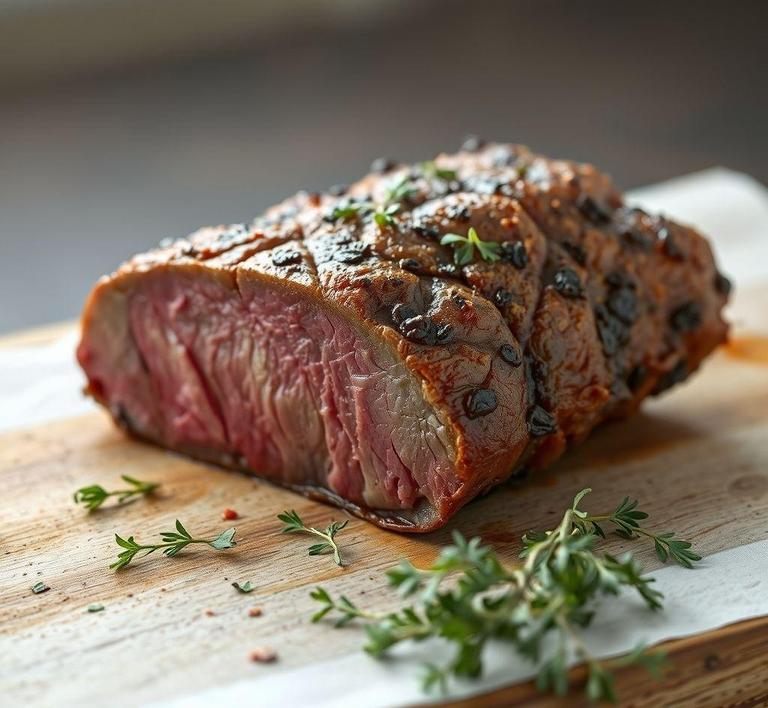If you’ve ever found yourself with leftover brisket and aren’t sure what to do with it, you’re not alone! Refreezing brisket can be a great way to preserve that delicious smoky flavor for later, but there are a few things to keep in mind to ensure it still tastes amazing when you reheat it. Whether you cooked a whole brisket for a big gathering or just have a few slices left over, knowing how to properly refreeze and store it will help maintain its juicy texture and rich flavor. In this guide, we’ll walk you through the best practices for refreezing brisket without compromising its quality, so you can enjoy it down the road with minimal effort.
Can You Refreeze Brisket?

Brisket, a cut of beef that is prized for its tenderness and flavor when cooked properly, is often the centerpiece of large meals, such as BBQ gatherings or family roasts. Given its size, brisket is frequently prepared in bulk, which raises an important question for many cooks: Can you refreeze brisket?
The short answer is yes, you can refreeze brisket, but there are a few key considerations to ensure the best possible outcome. Brisket, like other cuts of meat, can be safely refrozen if handled properly throughout its preparation, storage, and thawing processes. The main factors that come into play here are food safety, quality, and the potential impact on texture and flavor. While freezing brisket can help extend its shelf life and reduce food waste, refreezing may not always be the most ideal choice depending on how the meat was originally cooked and thawed.
It’s important to note that meat should only be refrozen if it has been thawed in the refrigerator and not left at room temperature for extended periods. This helps prevent bacterial growth, ensuring the meat remains safe to eat. Additionally, while refreezing won’t necessarily make the brisket unsafe to eat, it may affect its quality-especially if it’s done multiple times.
How To Refreeze Brisket?
Refreezing brisket involves a few essential steps to maintain both its safety and quality. Here’s a detailed guide on how to properly handle brisket for refreezing:
1. Properly Thawing The Brisket
If you’ve already thawed your brisket once, you can refreeze it only if it has been defrosted in the refrigerator. This is the safest way to thaw meat because it prevents the growth of harmful bacteria that can develop at room temperature. Never refreeze brisket that has been thawed on the counter or in hot water, as these methods can lead to unsafe conditions for the meat. If you’re in a rush and need to speed up the thawing process, the microwave is another option-but it may affect the texture and flavor, so it’s best used with caution.
2. Handling Leftovers Carefully
Once your brisket is cooked, portion it into smaller pieces before freezing to ensure it freezes and thaws evenly. This also makes it easier to defrost only what you need. It’s advisable to wrap the brisket tightly in plastic wrap or aluminum foil to prevent freezer burn, and then place it in an airtight container or freezer bag. Vacuum-sealing is the best option for preserving freshness and preventing air from degrading the quality of the meat. Make sure to label the package with the date of freezing so you can track how long it’s been stored.
3. Freezing The Brisket
When placing brisket in the freezer, ensure that it’s in the coldest part of the unit, ideally at or below 0°F (-18°C). This ensures the meat freezes as quickly as possible, which helps maintain its quality. Avoid placing the brisket in a freezer that is frequently opened or undergoing temperature fluctuations, as this can affect the meat’s texture upon refreezing.
4. Thawing For Refreezing
When it’s time to refreeze, thaw the brisket in the refrigerator again, not at room temperature. Ideally, thaw the brisket in a tray or pan to catch any drippings and prevent cross-contamination with other foods. After it’s completely thawed, you can then proceed with refreezing it following the same procedure of wrapping it tightly and placing it back in an airtight container or freezer bag.
Quality Impact
While refreezing brisket is safe as long as food safety protocols are followed, it can have an impact on the quality of the meat. The effects are especially noticeable in texture, flavor, and moisture content.
1. Texture And Moisture Loss
One of the biggest drawbacks of refreezing brisket is the loss of moisture. The freezing process causes water inside the meat to form ice crystals, which can rupture the muscle fibers and cause the brisket to lose its juiciness. When you refreeze brisket, the process is repeated, and the ice crystals formed during the second freeze may further damage the meat’s cellular structure. This results in a dry, less tender texture when the brisket is eventually reheated.
If the brisket was cooked to a tender, fall-apart consistency initially, refreezing may diminish that perfect texture, turning it into something a little tougher and less desirable. Slow-cooked brisket that has been frozen and then refrozen might lose its melt-in-your-mouth quality.
2. Flavor Deterioration
Another area where refreezing can take a toll is flavor. Freezing meat, particularly fatty cuts like brisket, can alter its natural flavor. The slow freezing and thawing processes can cause the fat to break down, leading to a loss of rich, beefy flavor. Additionally, if the brisket was cooked with seasonings or sauces, the flavors might not be as vibrant or fresh once the meat has been refrozen.
3. Freezer Burn
One of the most common issues when refreezing brisket is freezer burn. If the meat isn’t properly wrapped or sealed, air can get in and dry out parts of the meat, leading to freezer burn. Freezer-burned brisket can have an unpleasant taste and texture, making it less enjoyable to eat. Although the meat is still safe to eat, the visual and textural changes caused by freezer burn might make it less appetizing.
While you can refreeze brisket, it’s not always the best choice if you want to maintain the highest quality. Refreezing can cause a reduction in moisture, texture, and flavor, which might leave you with a less-than-satisfying eating experience. However, if you are in a situation where refreezing is necessary, there are steps you can take to minimize the negative effects, such as wrapping the meat carefully and storing it properly.
The key is to ensure that the brisket has been handled safely at all times, from thawing in the fridge to freezing at the right temperature. If you are planning to refreeze brisket, it’s important to manage expectations about the quality of the meat once it’s reheated, especially if it has been through multiple cycles of freezing and thawing.
Ultimately, for the best results, it’s recommended to only freeze brisket once, eat it within a reasonable time frame, and avoid frequent refreezing. If you have leftover brisket after a meal, you can always store it in the fridge for a few days or freeze it for later use, but keeping the freezing process to a minimum will help preserve the brisket’s amazing flavor and texture for the long term.
Is It Safe To Refreeze Brisket?
Refreezing brisket, like many other cuts of meat, is a topic that sparks debate in the culinary world. To answer the question of whether it’s safe to refreeze brisket, the primary concern comes down to food safety and quality. When you freeze meat, ice crystals form within the cells, potentially damaging the texture and flavor. However, if done properly, refreezing brisket is generally safe, though there are some important considerations to keep in mind.
Firstly, brisket should only be refrozen if it has been handled properly. That means you need to thaw the brisket safely in the fridge rather than at room temperature. If the meat has thawed and been sitting at room temperature for more than two hours, or worse, for several hours, bacteria could start to grow, making it unsafe to refreeze. Always check the internal temperature and feel the brisket-if it has been stored properly and the meat hasn’t exceeded 40°F (4°C), refreezing may still be an option.
Moreover, refreezing brisket multiple times is not recommended. Each time the meat is frozen and thawed, it loses moisture and the quality degrades. The tenderness, juiciness, and texture of the brisket can diminish with each freezing cycle. The key here is to limit the number of times you freeze the brisket to avoid compromising its quality.
In summary, refreezing brisket can be safe if it’s done within the right parameters (proper thawing and storage), but it’s important to weigh the potential impact on flavor and texture. If you’re looking for the best taste and texture, you may want to consider just freezing the brisket once and consuming it within a reasonable timeframe.
Signs That Brisket Should Not Be Refrozen
Although refreezing brisket can be safe under the right conditions, some signs indicate it should not be refrozen due to compromised safety or quality. Here are the key things to watch out for:
1. Off-Putting Odor
The smell of your brisket is an immediate indicator of its condition. If it smells sour, rancid, or unpleasant in any way, then it’s a sign of spoilage. Spoiled brisket should never be refrozen because bacteria and other pathogens could have taken over. Even if the brisket hasn’t fully spoiled, refreezing it will only lock in those undesirable odors and make the meat unpalatable.
2. Discoloration Or Slimy Texture
Brisket that has been left out too long or not stored properly may develop a slimy texture or off-color. If you notice a grayish-brown or greenish tint instead of the normal reddish-pink color, this could be a sign that bacteria are present. Similarly, if the surface of the brisket feels sticky or slimy, this is another indicator that it’s no longer safe to eat, let alone refreeze.
3. Excessive Ice Crystals
When brisket is frozen, ice crystals naturally form. However, if you notice a thick layer of ice crystals inside the packaging when you go to refreeze the meat, it could be a sign that the brisket was not stored properly to begin with, or it has been thawed and refrozen multiple times. This compromises the texture and moisture of the meat, making it unsuitable for a second freezing. Excessive ice crystals indicate that the meat has already undergone some degradation in quality, and refreezing could worsen this.
4. Room Temperature Exposure For Too Long
If brisket has been sitting at room temperature for more than two hours, it has entered the danger zone (40°F-140°F or 4°C-60°C). At this temperature, bacteria can multiply rapidly. Refreezing meat that has been in the danger zone for too long is unsafe, as the bacteria may not be killed even through refreezing.
5. Unreliable Packaging
If the brisket was not sealed properly during its initial freezing process-whether that means the bag was punctured, or the wrap wasn’t tight-then moisture loss could already have occurred, affecting the texture of the meat. Exposure to air can also cause freezer burn, which will compromise the quality and texture of the brisket, making it less than ideal for refreezing.
Common Refreezing Mistakes
Even if you’re trying to refreeze brisket with good intentions, there are common mistakes that can affect the safety and quality of the meat. Here are some of those pitfalls to avoid:
1. Not Allowing The Meat To Cool Properly Before Freezing
If you’ve cooked or reheated the brisket, it’s crucial to let it cool down before refreezing. Freezing it while still hot can lead to the formation of ice crystals inside the meat, which leads to moisture loss and texture degradation. Additionally, placing hot brisket directly in the freezer can raise the temperature inside, putting other food items at risk of spoilage.
2. Freezing Brisket In Subpar Packaging
Using inadequate packaging is a common mistake. Regular plastic wrap or a single layer of aluminum foil may not offer enough protection against freezer burn. It’s important to wrap the brisket tightly in plastic wrap, followed by a layer of heavy-duty aluminum foil or a vacuum-sealed bag to protect it from air exposure.
3. Refreezing After It’s Already Been Refrozen
If you’ve thawed brisket once, it’s usually best to cook it before refreezing. Repeated freezing and thawing will degrade the meat’s texture, and you risk creating conditions for bacteria to thrive. Freezing brisket that has already been frozen can cause irreparable damage to its flavor and safety.
4. Overloading The Freezer
Your freezer should maintain a consistent temperature of 0°F (-18°C). If you pack the freezer too full, the air circulation is compromised, and the brisket might not freeze quickly enough, leaving it in the danger zone for too long. Thawing or refreezing meat improperly in a cramped, overloaded freezer could cause significant safety risks.
Tips And Tricks
To ensure that your brisket remains safe and delicious when refreezing, here are a few tips and tricks to keep in mind:
1. Vacuum Seal The Brisket
Vacuum sealing is one of the best ways to prevent freezer burn and preserve the quality of the meat. If you don’t have a vacuum sealer, use heavy-duty freezer bags, and try to remove as much air as possible before sealing them.
2. Portion The Brisket
If you plan on freezing brisket, portion it out into smaller pieces before freezing. This will allow you to thaw only what you need, minimizing waste and preventing the need to refreeze larger portions.
3. Label Your Freezer Bags
Label each freezer bag with the date you froze the brisket, so you’ll know how long it’s been in the freezer. This way, you can plan to use it before the quality declines. Brisket can typically last 4-6 months in the freezer before its flavor starts to degrade.
4. Thaw Safely In The Refrigerator
When you need to thaw brisket, the safest method is to place it in the fridge for a gradual thaw. Never thaw brisket at room temperature, as this increases the risk of bacterial growth. If you’re in a hurry, you can also thaw it in a cold-water bath, ensuring the meat is fully submerged and the water stays cold.
5. Reheat Gently
When reheating refrozen brisket, it’s best to do so slowly to retain moisture. You can use low heat in the oven or stovetop, covering the brisket with foil to lock in juices. Avoid microwaving brisket, as it can make the meat rubbery and dry.
Conclusion
In conclusion, while refreezing brisket is generally safe, it’s important to follow proper food safety and handling practices to maintain both the safety and quality of the meat. Signs like off odors, discoloration, and excessive ice crystals can be indicators that refreezing is no longer a good option. To avoid common mistakes like inadequate packaging or repeated freezing cycles, make sure to store the brisket properly in the first place, and always thaw and reheat with care. By following these tips and being mindful of the condition of the meat, you can enjoy your brisket long after the initial cooking, with minimal loss in flavor and texture.

